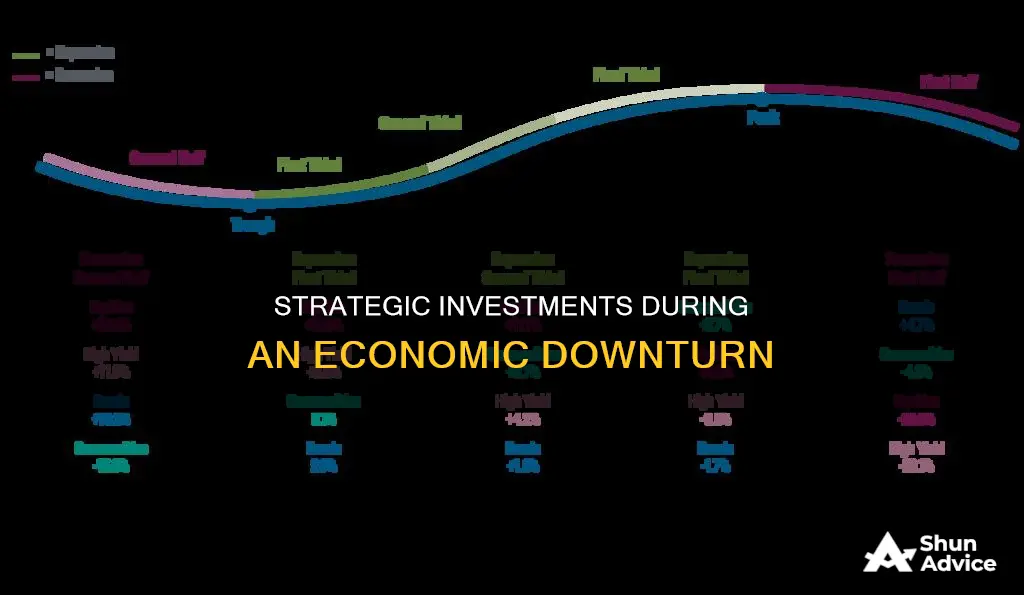
Economic downturns are a part of the economic cycle, and while they don't last as long as expansions, they can be costly for investors. From 1928 to 2023, the S&P 500 had 18 corrections with losses ranging from 10% to 20%, with an average loss of 13.4%. As such, investors need to be cautious and vigilant in monitoring the market landscape for opportunities to pick up high-quality assets at discounted prices.
During a recession, investors should avoid highly leveraged, cyclical, and speculative companies as they pose the biggest risk of performing poorly during tough economic times. Instead, investors should focus on well-managed companies with low debt, good cash flow, and strong balance sheets.
Some industries are considered more recession-resistant than others, such as utilities, consumer staples, and discount retailers. Investing in real estate can also be a good option as it is less volatile, produces income, and provides utility.
Additionally, investors should consider diversifying their portfolios and taking a long-term view. While it can be tempting to try and time the market, it is difficult to predict recessions accurately. Therefore, a better strategy may be to focus on building a portfolio of high-quality companies with strong fundamentals that can weather economic downturns.
| Characteristics | Values |
|---|---|
| Riskier assets | Stocks, high-yield bonds |
| Assets that appreciate | Gold, US treasuries |
| Companies to invest in | Large companies with ample, steady cash flows and dividends |
| Companies to avoid | Highly leveraged companies, cyclical companies, speculative companies |
| Industries to invest in | Utilities, consumer staples, discount retailers, defence |
| Industries to avoid | Luxury, non-essential goods and services |
What You'll Learn

Invest in real estate
Real estate is a less volatile and more stable investment than stocks and bonds, making it an attractive prospect during an economic downturn. It can act as a hedge in a stock market crash, as money tends to flow into treasury bonds and tangible assets.
Advantages of Investing in Real Estate During an Economic Downturn
- Real estate is a tangible asset that can grow in value over time, providing a hedge against inflation.
- It offers stable income and diversification benefits, reducing exposure to volatile stock markets.
- Housing is a basic need, and demand for rental properties may increase as people lose their homes or choose to delay purchasing during an economic downturn.
- Real estate assets are less susceptible to wild price swings and can offer better returns than bonds.
- Policy interventions during financial crises often benefit both the supply and demand sides of the real estate market.
- Real estate investments are less likely to suffer total loss compared to other assets, even in the face of natural disasters or political conflicts.
- During crises, fiscal stimulus spending and monetary policy interventions can benefit the real estate sector.
- Single-family rental assets recorded positive values during the Great Depression, demonstrating real estate's resilience.
- Real estate assets are often quicker to rebound from downward volatility caused by crises.
Considerations and Risks
- Interest rates tend to decrease during recessions, impacting borrowing costs and financial liquidity.
- There is a risk of being over-leveraged if investing too much in housing expenses, taxes, etc., leading to negative cash flow.
- Job losses and reductions in consumer spending during a recession may impact tenants' ability to pay rent.
- It is important to have a solid financial foundation, a high credit score, and strong cash flow when investing in real estate during a recession.
Strategies for Investing in Real Estate During an Economic Downturn
- Stress-test your real estate portfolio by running different scenarios to identify fragile properties.
- Focus on short-term goals, such as reviewing expenses and proactively extending leases, to maintain cash flow and stability.
- Monitor expenses to ensure they are returning an ROI, either through financial gains or increased free time for tenant outreach.
- Invest in technology and systems to move your real estate business online, such as virtual tours, digital rental applications, and digital lease execution platforms.
- Build relationships with tenants, allowing reasonable lease changes, prioritizing communication, and carefully screening new tenants.
- Stick to your long-term business plan and avoid panic selling.
- Develop a strategic business plan, including understanding key metrics like IRR, cap rates, and net operating income.
- Increase marketing and branding efforts to capitalise on increased internet usage during a recession and capture market share from competitors.
- Build a war chest of cash by delaying discretionary expenses, paying down mortgages, and increasing equity reserves.
- Develop relationships with local credit unions and banks, and consider a home equity line of credit to quickly access cash for investment opportunities.
Investing in real estate during an economic downturn can be a profitable strategy, offering diversification, stable income, and the potential for long-term capital appreciation. However, it is important to carefully assess the risks, build a solid financial foundation, and implement strategic business practices to maximise the chances of success.
Ally Invest Trade Times in Managed Portfolios
You may want to see also

Invest in gold
Gold is a good investment during an economic downturn because it is a safe-haven asset that acts as a hedge against inflation and the potential volatility of other assets. Gold has a long record of being valued by humans for its beauty and use as a source of wealth and a means of exchange. This makes people confident that gold will retain its value.
Gold has intrinsic value due to its properties, such as beauty, malleability, and low corrosion, which make it useful in both cultural and industrial settings. As a result, gold has typically acted as a hedge against inflation and currency devaluation. While the purchasing power of the US dollar has declined over time, the purchasing power of gold generally remains steady or increases. Gold, therefore, provides a way to protect against the rapid erosion of purchasing power and wealth during periods of inflation, which often coincide with recessions.
Gold also provides a smart tactic for diversifying an investment or trading portfolio during recessions. By including an asset that typically outperforms stocks, traders and investors can theoretically sharply minimize downside risk during times of poor market performance. The easy accessibility of gold ETFs and futures also ensures that traders and investors have a liquid mechanism by which to trade gold.
Historical analysis shows that the value of gold has increased in three out of four recessions. In the recession of 1980-1982, gold jumped an astounding 46% while the S&P 500 dropped 27%. During the 2000-2002 dot-com crash, gold jumped 12% while the S&P 500 dropped a staggering 49%. Similar disparities have been seen during Black Monday in 1987, the Global Financial Crisis in 2008, and several other periods of massive stock market decline.
Gold's value increases during recessions because investors view it as a safe harbour when they are worried about currencies being devalued via loose monetary policy or their purchasing power disappearing through inflation. Gold provides an alternative option in these scenarios. Traders who are more focused on portfolio performance can also view historical charts, which show that gold has often been a smart asset to invest in during recessions or other periods of economic turmoil.
However, it is important to note that gold is not a risk-free investment. While gold has an inherently limited supply, which makes it an effective hedge against inflation, it is still affected by market uncertainty and other economic factors.
Public Investment Portfolio: Understanding Government's Investment Strategies
You may want to see also

Invest in US Treasury bonds
US Treasury bonds are long-term debt securities issued by the US government. They have maturities of 20 to 30 years and pay a fixed interest rate semi-annually.
US Treasury bonds are considered a safe investment during a recession. During times of market volatility, investors often flock to these bonds, seeking stability. They are also backed by the full faith and credit of the US government, making them a low-risk investment.
Stability and Low Risk
US Treasury bonds offer stability and are considered low-risk investments. They are backed by the full faith and credit of the US government, which means that there is a guarantee of repayment, making them relatively safe compared to other investments. This can be especially attractive during uncertain economic times.
Fixed Interest Payments
Treasury bonds provide fixed interest payments, which means investors receive a consistent return. This can be advantageous during volatile economic periods when stock prices fluctuate. The fixed interest can provide a stable source of income, reducing overall portfolio risk.
Long-Term Investment
With maturities ranging from 20 to 30 years, US Treasury bonds are long-term investments. This can be beneficial if you are investing for the long term and want to avoid the short-term fluctuations that come with other types of investments.
Diversification
Including US Treasury bonds in your investment portfolio can help with diversification. They often move inversely to stocks, so they can balance out the performance of other assets in your portfolio. This diversification can help reduce overall risk and provide a hedge against stock market volatility.
Capital Preservation
During an economic downturn, capital preservation becomes a priority for many investors. US Treasury bonds can offer a safe haven for your capital, protecting it from the more significant losses that can occur in other asset classes during a recession.
Buying Opportunity
When the economy weakens, US Treasury bonds may become more attractive as their prices can drop. This provides an opportunity to buy these bonds at a lower price, potentially resulting in higher returns over the long term.
In summary, investing in US Treasury bonds during an economic downturn can offer stability, income, and capital preservation. They are a safe haven for investors seeking to reduce risk and diversify their portfolios. However, it is important to remember that all investments carry some level of risk, and economic downturns can also present opportunities in other asset classes. Therefore, it is essential to carefully consider your investment goals and conduct thorough research before making any investment decisions.
Invest Wisely: A Guide to Savings in Australia
You may want to see also

Invest in high-quality companies
During an economic downturn, investors need to act cautiously but remain vigilant in monitoring the market landscape for opportunities to pick up high-quality assets at discounted prices.
When investing in high-quality companies during a recession, it is important to look for companies with strong balance sheets, low debt, and good cash flow. These companies are often in industries that are considered recession-resistant, such as utilities, consumer staples, and discount retailers.
- Strong Balance Sheets: Look for companies with low debt, healthy cash flows, and profitability. These companies are less vulnerable to tightening credit conditions and can more easily manage their debt obligations.
- Recession-Resistant Industries: Some industries perform well during recessions. Consumer staples, grocery stores, discount stores, and utility companies tend to do well because their products or services remain in demand regardless of the economic climate.
- Well-Managed Companies: Invest in companies with strong management teams that have a history of making prudent financial decisions. Well-managed companies are more likely to navigate through economic downturns successfully.
- Avoid High-Risk Investments: Stay away from highly leveraged, cyclical, or speculative companies during a recession. These companies often carry a high risk of performing poorly during tough economic times and may go bankrupt.
- Long-Term Perspective: Remember that investing in high-quality companies during a recession is a long-term strategy. It may take time for the market to recover, but high-quality companies are more likely to weather the storm and come out stronger on the other side.
By following these guidelines, investors can position themselves to not only survive but also thrive during an economic downturn by investing in high-quality companies with strong fundamentals and favourable industry positioning.
Investments to Make: Where to Put Your Money
You may want to see also

Diversify your portfolio
Diversifying your portfolio is a crucial strategy to protect your investments during an economic downturn. Here are some steps to achieve effective diversification:
Understand the Basics of Diversification:
Diversification is a risk management strategy that involves spreading your investments across various assets, sectors, and geographic locations. By allocating your capital to multiple areas, you reduce the impact of any single negative event on your overall portfolio.
Asset Allocation:
Diversify across different asset classes such as stocks, bonds, cash, and alternative investments. The proportion allocated to each asset class will depend on your risk tolerance, investment goals, and time horizon. Generally, stocks are riskier but offer higher potential returns, while bonds and cash provide more stability and income.
Sector and Industry Diversification:
Within the stock portion of your portfolio, ensure you are investing in a variety of sectors and industries. For example, consumer staples (e.g., food, beverages, household goods) tend to be more defensive during downturns, while sectors like technology and automotive can be more cyclical.
Geographic Diversification:
Consider investing in companies or funds that provide exposure to different countries and regions. This helps to reduce the impact of country-specific or regional economic shocks. For instance, you could invest in international stocks or global mutual funds.
Regular Portfolio Rebalancing:
Over time, the performance of different investments in your portfolio will vary, causing your original allocation to shift. To maintain your desired level of diversification, periodically rebalance your portfolio by buying or selling assets to return to your target allocation.
Avoid Overdiversification:
While diversification is essential, be cautious not to overdo it. Overdiversification can dilute the potential returns of your portfolio and may result in average, rather than exceptional, performance. Focus on selecting quality investments within each asset class and sector.
By implementing these diversification strategies, you can enhance the resilience of your portfolio during economic downturns and position yourself to take advantage of the eventual recovery.
How to Make a Cash Investment Wisely?
You may want to see also
Frequently asked questions
During an economic downturn, it is wise to invest in safer assets such as government bonds, defensive stock sectors (utilities, consumer staples, and healthcare), and cash reserves.
During an economic downturn, it is wise to avoid investing in high-risk assets such as small-cap stocks, cryptocurrencies, and overly leveraged companies.
Here are some strategies to protect your portfolio during an economic downturn:
- Diversify your investments across different asset classes and sectors.
- Focus on investing in large, established companies with strong balance sheets, healthy cash flows, and low debt.
- Avoid investing in speculative or highly leveraged companies.
- Consider investing in recession-resistant industries such as consumer staples, utilities, and discount retailers.
- Monitor the market for opportunities to acquire high-quality assets at discounted prices.







